"Cherishing Little Steps - A Haven for Baby and Family Journeys"
Creating a Peaceful Sleep Environment
They say, ‘A good night’s sleep is a recipe for a successful day.’ And if you’ve ever experienced the frustration of tossing and turning, you know just how true that adage is.
So, how can you create a peaceful sleep environment that will help you wake up refreshed and ready to tackle the day? Well, my friend, in this discussion, we will explore some practical tips and strategies that will transform your bedroom into a tranquil sanctuary where sleep comes effortlessly.
Get ready to discover the secrets to a restful night’s sleep like you’ve never experienced before.
Key Takeaways
- Choosing the right mattress (memory foam, innerspring, hybrid)
- Controlling the temperature (ventilation, natural bedding materials)
- Investing in quality pillows (proper alignment, pillow maintenance)
- Selecting soothing colors (soft neutrals, cool blues and greens)
Choose the Right Mattress

Are you struggling to find the perfect mattress for a peaceful night’s sleep? Choosing the right mattress is essential for creating a sleep environment that promotes relaxation and rejuvenation. With the wide variety of mattress types and sizes available, it can be overwhelming to make the right choice. Let’s break it down.
When it comes to mattress types, there are a few common options to consider. Memory foam mattresses provide excellent support and contour to your body, relieving pressure points and ensuring a comfortable sleep. If you prefer a bouncier feel, an innerspring mattress might be the right choice for you. These mattresses use coils to provide support and responsiveness. Another option is a hybrid mattress, which combines the benefits of both memory foam and innerspring mattresses to offer a balance of comfort and support.
In addition to mattress types, mattress size is another important factor to consider. The most common sizes are twin, full, queen, and king. While twin mattresses are ideal for single sleepers or children, full mattresses offer more space for individuals who like to spread out. Queen mattresses are a popular choice for couples, providing enough space for two people to sleep comfortably. Lastly, king mattresses offer maximum space, perfect for couples who prefer their own sleeping area or for those who like to share their bed with children or pets.
Optimize Your Bedroom Lighting
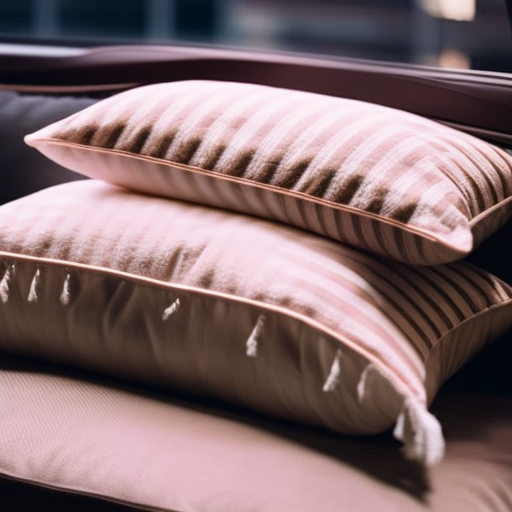
Now that you have chosen the right mattress, it’s time to optimize your bedroom lighting for a peaceful sleep environment. The right lighting can significantly impact your sleep quality and help you relax before bedtime. To create a soothing atmosphere, consider the following tips:
-
Dimming lights: Install dimmer switches or use dimmable bulbs in your bedroom. This allows you to adjust the brightness according to your preferences. Dimming the lights in the evening signals to your body that it’s time to wind down and prepare for sleep.
-
Natural lighting: During the day, let in as much natural light as possible. Natural light helps regulate your body’s internal clock, promoting a healthy sleep-wake cycle. Keep your curtains or blinds open to allow sunlight to enter your room. If privacy is a concern, opt for sheer curtains or blinds that let in light while still maintaining privacy.
Here’s a table summarizing the tips for optimizing your bedroom lighting:
| Tip | Description |
|---|---|
| Dimming lights | Install dimmer switches or use dimmable bulbs to adjust the brightness in your bedroom. Dimming the lights in the evening helps your body prepare for sleep. |
| Natural lighting | Let in as much natural light as possible during the day. Sunlight helps regulate your body’s internal clock and promotes a healthy sleep-wake cycle. Keep curtains or blinds open to allow sunlight to enter your room. |
Declutter Your Sleep Space
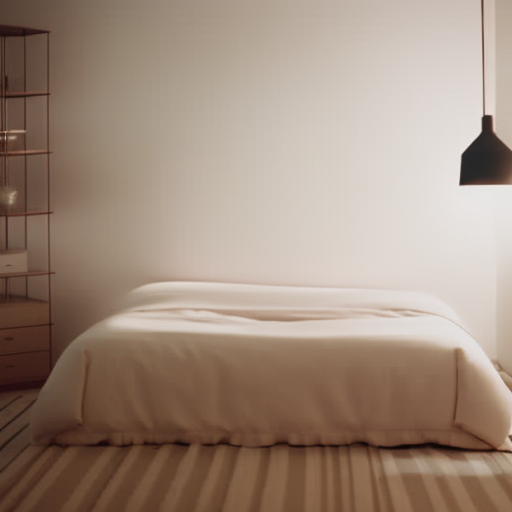
To create a peaceful sleep environment, it’s important to declutter your sleep space. A cluttered bedroom can lead to feelings of anxiety and restlessness, making it difficult to relax and fall asleep. Adopting a minimalist design approach can help create a sense of calm and tranquility in your sleep space.
One way to declutter your sleep space is to remove any unnecessary furniture or decor. Keep only the essentials, such as a bed, nightstand, and a few meaningful items. This minimalist approach promotes a sense of spaciousness and allows for better flow of energy, according to Feng Shui principles.
In addition to furniture, it’s important to organize and declutter your belongings. Clear out any excessive clutter, such as clothes, books, or electronics, that may be taking up valuable space. Creating designated storage areas for items and implementing a regular cleaning routine will help maintain a clutter-free environment.
Control the Temperature

To further enhance the peacefulness of your sleep environment, an important aspect to consider is controlling the temperature. Maintaining a comfortable temperature in your bedroom can greatly impact the quality of your sleep. To do this, it’s crucial to maintain proper ventilation and use natural bedding.
Proper ventilation is essential for a cool and fresh sleep environment. Make sure your bedroom has adequate air circulation by opening windows or using a fan to circulate the air. This helps prevent stuffiness and ensures a constant supply of fresh air throughout the night.
Using natural bedding can also contribute to a comfortable sleep temperature. Natural materials like cotton and bamboo are breathable and help regulate body temperature, keeping you cool in the summer and warm in the winter. Avoid synthetic materials that trap heat and moisture, as they can lead to discomfort and poor sleep quality.
Invest in Quality Pillows

Investing in quality pillows is essential for creating a comfortable and supportive sleep environment. Your pillow plays a significant role in providing proper alignment and support for your head, neck, and spine. A good quality pillow can help alleviate neck and back pain, reduce snoring, and improve overall sleep quality.
To ensure your pillows stay in optimal condition, proper maintenance is crucial. It’s recommended to fluff and rotate your pillows regularly to maintain their shape and prevent them from becoming flat and lumpy. Additionally, using pillow protectors can help protect against allergens, dust mites, and stains, increasing the longevity of your pillows.
If you’re looking for alternatives to traditional pillows, there are a few options to consider. Memory foam pillows conform to the shape of your head and neck, providing personalized support. Latex pillows offer similar benefits with a more natural and breathable material. Additionally, buckwheat pillows are filled with buckwheat hulls, which contour to your head and neck while promoting airflow.
Select Soothing Colors
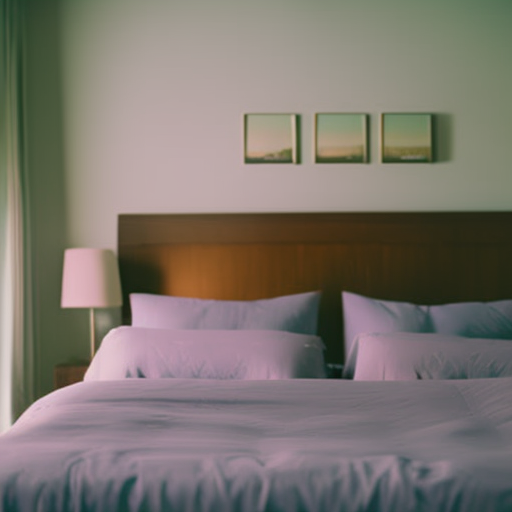
Maintaining a peaceful sleep environment extends beyond investing in quality pillows; the colors you choose for your bedroom can significantly impact your ability to relax and unwind.
When it comes to selecting soothing colors for your sleep sanctuary, consider the following:
-
Soft neutrals: Opt for calming shades of beige, taupe, or pale gray to create a serene atmosphere. These hues promote a sense of tranquility and provide a neutral backdrop that complements various decor styles.
-
Cool blues and greens: Research suggests that these colors can lower heart rate and blood pressure, inducing a calm and relaxed state. Shades like light blue or mint green can evoke a sense of serenity and mimic the soothing effects of nature.
-
Avoid bold and vibrant colors: While bright colors may be visually appealing, they can be stimulating and hinder relaxation. Save bold hues for accents or accessories rather than painting entire walls with them.
-
Consider warm tones: Soft, warm colors like blush pink or light lavender can create a cozy and comforting atmosphere. These gentle hues can help create a sense of relaxation and ease stress.
Block Out Noise
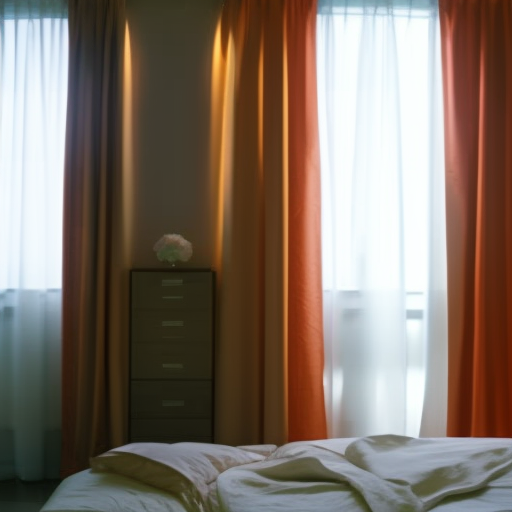
Are you tired of being disturbed by outside noises while you’re trying to sleep? Creating a peaceful sleep environment is essential for a good night’s rest, and one of the key factors in achieving this is blocking out noise. Whether it’s traffic, noisy neighbors, or a snoring partner, unwanted sounds can significantly disrupt your sleep. Fortunately, there are soundproofing solutions and white noise machines that can help create a quieter sleeping environment.
| Soundproofing Solutions | White Noise Machines |
|---|---|
| Install thick curtains or blinds to block out external sounds | Use a white noise machine to mask background noises |
| Seal gaps and cracks in windows and doors to prevent noise leakage | Opt for a machine that offers different sound options, such as rain or waves |
| Place a bookshelf or heavy furniture against the wall adjacent to the noisy area | Consider a portable white noise machine for travel or when staying in unfamiliar places |
Soundproofing solutions involve physically blocking or reducing the entry of external noise into your bedroom. This can be achieved through the use of noise-blocking curtains, window sealants, or furniture placement. Additionally, white noise machines can help mask disruptive sounds by providing a constant, soothing sound that helps to drown out other noises. These machines are particularly useful for those who have trouble falling asleep or staying asleep due to environmental sounds.
Enhance Air Quality

To improve the quality of air in your bedroom, consider implementing these simple strategies.
-
Use air purifiers:
-
Air purifiers are effective in removing allergens, pollutants, and odors from the air.
-
Look for models with HEPA filters, as they’re highly efficient in capturing microscopic particles.
-
Place the air purifier near your bed to ensure that you breathe in cleaner air while you sleep.
-
Bring in some plants:
-
Plants not only add a touch of nature to your bedroom but also act as natural air purifiers.
-
They absorb carbon dioxide and release oxygen, improving the air quality.
-
Some plants, such as the snake plant and the peace lily, are known to filter out harmful toxins like formaldehyde and benzene.
Incorporate Relaxing Scents
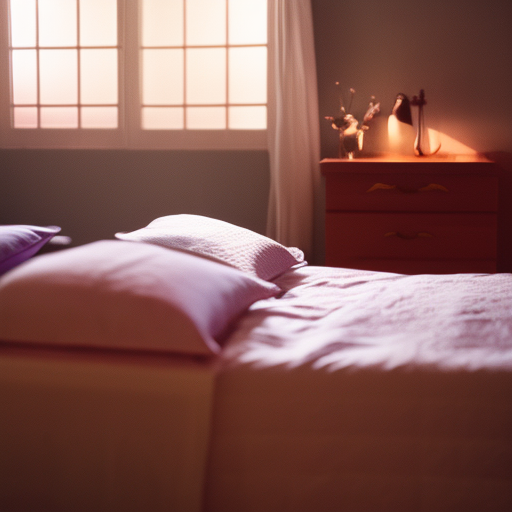
Enhance the ambiance of your peaceful sleep environment by introducing soothing aromas that promote relaxation and restfulness. Incorporating relaxing scents into your sleep routine can enhance the effectiveness of relaxation techniques and provide additional benefits through aromatherapy.
Aromatherapy is the practice of using essential oils to promote physical and psychological well-being. When inhaled, the molecules of these oils interact with the olfactory system in your brain, triggering various responses. Lavender, for example, has been shown to reduce anxiety and promote relaxation, making it an excellent choice for your sleep environment. Other scents like chamomile, ylang-ylang, and bergamot have also been found to have calming effects, helping you unwind and prepare for a restful night’s sleep.
To incorporate these scents into your sleep environment, you can use a variety of methods. One option is to use an essential oil diffuser, which disperses the scent into the air. Another option is to apply a few drops of essential oil to a cotton ball and place it near your bed. You can also use scented candles or linen sprays to create a calming atmosphere.
Create a Technology-Free Zone

Consider establishing a designated area in your sleep environment where technology isn’t allowed to create a peaceful and technology-free zone. This technology-free zone will help you disconnect from the constant stimulation of screens and create a space that promotes relaxation and restful sleep. Here are some reasons why you should consider implementing a technology-free zone:
-
Improved Sleep Quality: The blue light emitted by screens can disrupt your sleep-wake cycle and make it harder for you to fall asleep. By keeping technology out of your sleep environment, you can create a space that’s conducive to quality sleep.
-
Reduced Mental Stimulation: Constant exposure to technology can overload our brains with information, making it difficult to unwind and relax. By creating a technology-free zone, you can give your mind a break from the constant digital stimulation and allow it to recharge.
In order to create a successful technology-free zone, consider the following tips:
-
Set Clear Boundaries: Establish rules and communicate them to yourself and your household members. Make it clear that the designated area is a technology-free zone, and encourage everyone to respect and adhere to the rules.
-
Remove Temptations: Keep all electronic devices, such as smartphones and tablets, out of the technology-free zone. Store them in a different room or turn them off completely to avoid the temptation of using them before bed.
Use Blackout Curtains or Blinds
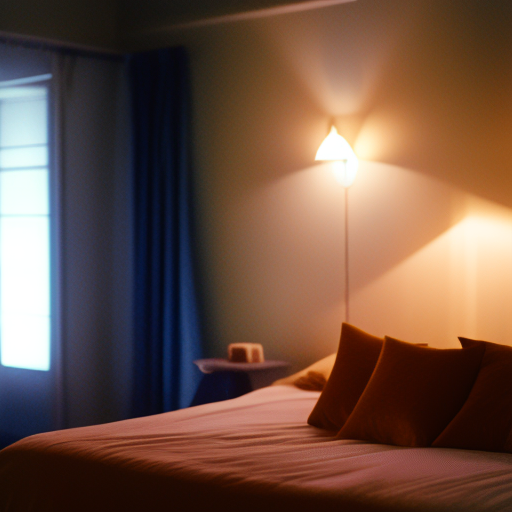
You can create a more peaceful sleep environment by incorporating blackout curtains or blinds. These window coverings are specifically designed to block out external light, creating a dark and serene atmosphere in your bedroom. Blackout curtains are made with a special lining that prevents light from penetrating through the fabric, while blackout blinds are constructed using materials that effectively block out light. By using blackout curtains or blinds, you can eliminate any unwanted light sources, such as streetlights or early morning sun, that may disrupt your sleep.
The benefits of using blackout curtains or blinds extend beyond just blocking out light. These window coverings can also help with noise reduction, as they can act as a barrier between your bedroom and any outside noise. Additionally, blackout curtains or blinds can offer privacy by preventing people from seeing into your bedroom from the outside.
While blackout curtains or blinds are highly effective, some individuals may prefer using sleep masks instead. Sleep masks are a great alternative for those who may not have the option to install blackout curtains or blinds, such as when traveling or staying in unfamiliar places. Sleep masks create a complete darkness around your eyes, allowing you to block out any light and achieve a more restful sleep.
Incorporating blackout curtains, blinds, or sleep masks into your sleep environment can greatly enhance your sleep quality by creating a dark and peaceful space. Consider investing in these options to improve your sleep and wake up feeling refreshed and rejuvenated.
Establish a Relaxing Bedtime Routine

Establishing a relaxing bedtime routine can greatly contribute to a peaceful and restful night’s sleep. By following a consistent routine, you can signal to your body and mind that it’s time to wind down and prepare for sleep.
Here are some steps you can take to establish a calming routine:
-
Create a peaceful environment:
-
Dim the lights in your bedroom to promote relaxation.
-
Play soft, soothing music or use white noise to drown out any distracting sounds.
-
Engage in relaxing activities:
-
Take a warm bath or shower to help relax your muscles and relieve tension.
-
Practice deep breathing exercises or gentle stretching to release any built-up stress.
Frequently Asked Questions
How Can I Incorporate Relaxing Scents Into My Sleep Environment?
You can incorporate relaxing scents into your sleep environment by using aromatherapy diffusers and incorporating essential oils. These methods have been shown to promote relaxation and improve sleep quality.
What Are Some Ways to Enhance Air Quality in My Bedroom?
To enhance air quality in your bedroom, consider incorporating purifying plants like snake plants or peace lilies. Additionally, using an air purifier can help remove pollutants and allergens, creating a healthier sleep environment.
Why Is It Important to Create a Technology-Free Zone in the Bedroom?
It’s important to create a technology-free zone in your bedroom because it helps promote better sleep. The presence of electronic devices can interfere with your ability to relax and unwind, making it harder to fall asleep and stay asleep throughout the night.
How Can Blackout Curtains or Blinds Help Improve My Sleep Environment?
Blackout curtains or blinds can greatly improve your sleep environment by blocking out external light and creating a dark and cozy atmosphere. This enhances melatonin production, regulates your sleep-wake cycle, and promotes a more restful and rejuvenating sleep.
What Are Some Tips for Establishing a Relaxing Bedtime Routine?
To establish a relaxing bedtime routine, start by incorporating soothing music into your routine. This can help you unwind and prepare your mind for sleep. Try to establish a calming pre-sleep routine that signals to your body that it’s time to rest.
Conclusion
In conclusion, by following these simple steps, you can create a peaceful sleep environment that promotes a restful night’s sleep.
Choosing the right mattress, optimizing your bedroom lighting, decluttering your sleep space, and controlling the temperature are all effective strategies. Investing in quality pillows, incorporating relaxing scents, creating a technology-free zone, and using blackout curtains or blinds are also key factors.
By implementing these changes, your bedroom will be as tranquil as a calm lake on a moonlit night, allowing you to drift off into a blissful slumber.



Thank you for your sharing. I am worried that I lack creative ideas. It is your article that makes me full of hope. Thank you. But, I have a question, can you help me?
Wow, marvelous blog structure! How lengthy have you ever been blogging for?
you make running a blog look easy. The total look of your
site is excellent, let alone the content material!
You can see similar here dobry sklep